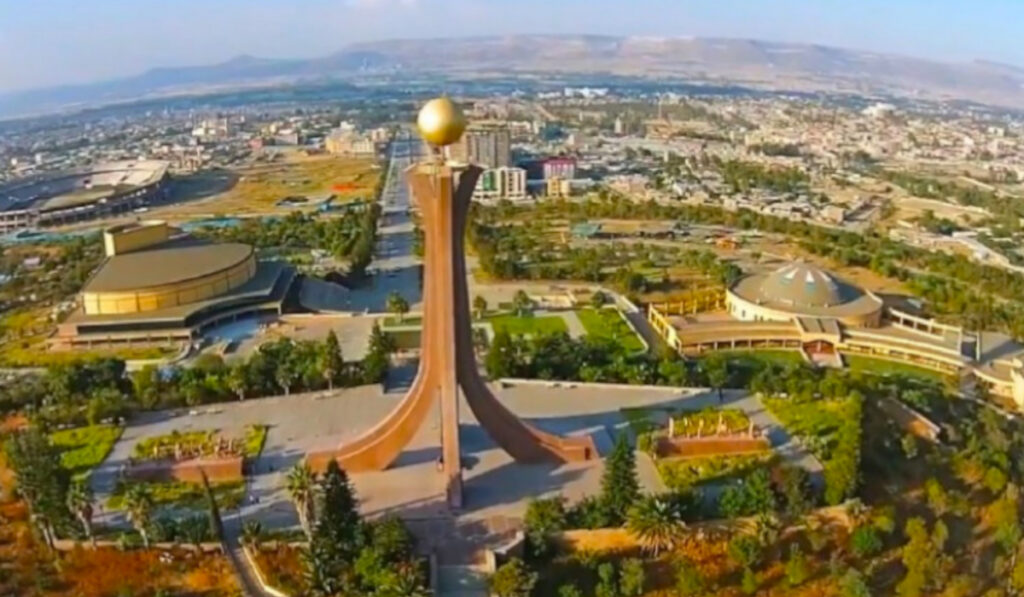
Farmers in Amhara region queuing to demand fertilizer. Photo: Amhara Media Corporation.
Addis Abeba – This week witnessed protests in various cities and towns by the peasantry in the Amhara regional state who demanded access to and timely delivery of fertilizer as the main planting season is dawning on them, and fears of missed planting season grip farmers whose livelihood is dependent on subsistence farming.
In the Amhara region, the farmers’ demand for fertilizer has left agricultural stations and has become a topic at the regional President’s office, according to regional media. “Recently, the farmers of Bahir Dar and the surrounding areas have hung their yokes, left their cattle and fields, and marched to Bahir Dar, the capital of the region”, the media admitted. They did so to complain to the higher authorities about the problems they were facing.
From the complaints by the farmers about delays in distribution, to the problem of fair distribution of fertilizer, the situation has worsened of late. On 30 May hundreds of protesting farmers took to the streets of Bahir Dar chanting slogans that they have been “waiting with hope” that they will receive fertilizer from one day to the next, but have run out of patience now; they have also expressed their fears that the shortage may force them abandon farming preparations for the coming season in June-July. “Give us fertilizer”, “Solve the fertilizer problem!” were some of the banners on display.
A crisis simmering for over a year
The latest protests may have caught the media’s attention, but the problem has been simmering for a over a year now. Farmers in East Gojjam Zone of Amhara region were the first to ring the alarm bell with zonal authorities in March last year with their concerns both on the lack of supply and the rising cost of fertilizer ahead of the year’s planting season.
Agriculture Minister Girma Amente said that the federal government has subsidized 21 Billion Birr for the procurement of fertilizer in preparation for the current crop season
The fears by the Gojam farmers came in the midst of two crisis: Ethiopia’s war which started in the Tigray region and had by then spread to both Amhara and Afar regional states, and the potential disruption in the global supply of fertilizer following Russia’s invasion of Ukraine. The Fertilizer Institute (TFI) had issued warning at the time that the war “will add additional pressure on a market that has already experienced many challenges over the last 18 months.”
Briefing local journalists of state owned media in mid-March this year, Agriculture Minister Girma Amente said that the federal government has subsidized 21 Billion Birr for the procurement of fertilizer in preparation for the current crop season. Some 12.8 million quintals of fertilizer has already been bought for for this year’s planting season; with two million quintals left over from last year, current stock of around 15 million quintals of fertilizer will be supplied to farmers across the country both for the belg (small rainy season) and the main rainy season, according to the minister.
However, according to the Minister, only about 30% of the fertilizer reached the port of Djibouti by the time he briefed the media in March, of which about 90% was transported to regional warehouses.
Ajebe also admitted that anticipating that there will be no shortage of soil fertilizer in the current fiscal year, the region began to distribute what has arrived there “in large quantities” from central whorehouse to remote districts and zones, “which has also distorted the fairness of the distribution.”
This week, Addis Standard reached out to Amsalu Gobaw, Head of Public Relations Department of the Amhara Regional State Agriculture Bureau, for comments. “There was a problem with the distribution of fertilizer and the office is working hard to solve this problem; I have nothing more to say,” Amsalu said. He declined to give more information.
However, Ajebe Seneshaw, Deputy Head of the Region’s Agriculture Bureau, told the regional state’s media that the shortage of fertilizer is “a national problem.”
With plans to harvest 150 million quintals in the current crop season, the bureau has requested the procurement of 9.2 million quintals of fertilizer, of which only 5.2 million quintals was procured and arrived in the region so far, Abeje revealed, adding and even that has not been efficiently distributed to the farmers, which has become a source of complaint for the farmers.
Like the PR head of the bureau, the deputy head too said the bureau is “working to overcome the problems” at the moment, and added that “attention has been given to the speedy and fair distribution of the fertilizer that has arrived in the region.”
Ajebe also admitted that anticipating that there will be no shortage of soil fertilizer in the current fiscal year, the region began to distribute what has arrived there “in large quantities” from central whorehouse to remote districts and zones, “which has also distorted the fairness of the distribution.”
Be that as it may, the official have been giving contradictory statistic on the amount of fertilizer that arrived in the region. Earlier this week, Amsalu, the bureau’s PR head, said that the regional state has submitted a request to the Ministry of Agriculture to purchase 5.2 million quintals of fertilizer, but only 1.7 million quintals have been sent so far. The office is in talks with the relevant parties so that the remaining 3.5 million quintals can be sent quickly, Amsalu said.
In a separate interview the same official gave in the same week, he mentioned that the plan was to buy 9.2 million quintals of fertilizer at the regional level, and so far 5.2 million quintals of fertilizer have been purchased for the region, but due to various reasons, only around 700,000 quintals of fertilizer have been delivered to the farmers.
Ajebe wants to assure the farmers that the bureau is providing some 150,000 quintals of fertilizer on loan from the central warehouse of the Ethiopian Agricultural Works Corporation to the areas that will plan crops earlier that the rest.
He also expressed hopes that a resumption of the transportation of fertilizer, which has been stopped, is being expedited to overcome the problem. Around 350,000 quintals of fertilizer will be brought into the region this week, he promised. To facilitate that, the bureau will work farmers’ unions to basic measures to directly distribute to the farmers.
Whether or not the bureau delivers on the promises explained by Ajebe, the ongoing strike by the farmers in Amhara region could be a small picture in an increasing crisis Ethiopian farmers across the country are facing.
Addis Standard’s analysis from a year ago on soaring price of fertilizers revealed an increase in more than 150% compared to the year before. AS
 News: TPLF calls for full Implementation of Pretoria peace deal on second anniversary, citing ‘unfulfilled’ commitments
News: TPLF calls for full Implementation of Pretoria peace deal on second anniversary, citing ‘unfulfilled’ commitments Over 45 killed in Oromia’s North Shewa zone, including Wacale district administrator
Over 45 killed in Oromia’s North Shewa zone, including Wacale district administrator Addis Abeba Islamic Council secures reinstatement for Muslim students suspended over religious attire
Addis Abeba Islamic Council secures reinstatement for Muslim students suspended over religious attire NBE launches online interbank money market platform
NBE launches online interbank money market platform